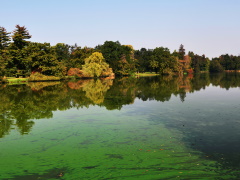Features
Old bacteria learn new tricks
Date: 2020-03-17 11:51:53.0
Author: Jon Evans

Cyanobacteria on the surface of a pond.
Photo: sangriana/Shutterstock.
Algae are not a particularly exclusive group of organisms, encompassing everything from unicellular microalgae to giant brown seaweed. Nevertheless, they tend to draw the line at cyanobacteria, despite them being commonly known as blue-green algae. This is because cyanobacteria are bacteria rather than eukaryotes, a completely different domain of life.
There is a direct connection, though, because cyanobacteria are thought to be one of the ancestors of all known photosynthesizing organisms, including algae and terrestrial plants. The idea is that over a billion years ago photosynthesizing cyanobacteria became incorporated within non-photosynthesizing unicellular organisms to form the first plant cells, eventually turning into the chloroplasts that conduct photosynthesis in plants and algae.
Despite this connection, today’s algae and cyanobacteria are actually quite different, with different abilities. For a start, algae can produce oil, especially when under nutrient-poor conditions, which is why they are used as a biofuel feedstock. Cyanobacteria, on the other hand, don’t tend to produce oil and so aren’t used as a biofuel feedstock.
One advantage cyanobacteria do have is that, as simpler photosynthesizing organisms, they are more amenable to genetic modification than algae. And as two recent studies show, this could allow them to be given abilities that match, and even surpass, those of algae.
The oils produced by algae are a mixture of triacylglycerols and wax esters, which they produce as a form of energy store, in case their nutrient supply runs out completely. Like the sugars they produce in normal times, the oils are synthesized in the chloroplasts. As cyanobacteria are the ancestors of these chloroplasts, a team of German scientists, led by Peter Dörmann at the University of Bonn, wondered whether cyanobacteria can actually produce triacylglycerol and wax esters, but perhaps in such small quantities that they had never been detected.
To find out, Dörmann and his team used mass spectrometry to perform a detailed analysis of all the lipids produced by a model species of cyanobacteria known as Synechocystis sp. PCC6803. They also analyzed the genome of this cyanobacteria to look for any genes that appeared similar to the gene that codes for an enzyme known as acyltransferase, which is integral to the production of triacylglycerols and wax esters in algae and plants.
As they report in a paper in the Proceedings of the National Academy of Sciences, they were able to detect both triacylglycerols and wax esters in the lipids produced by the cyanobacteria, albeit at very low concentrations. And they were also able to identify the acyltransferase gene responsible for producing the triacylglycerols and wax esters, which could hopefully offer a way to enhance those concentrations. "It is certainly possible that the oil yield could be significantly increased again with biotechnological means," confirmed Dörmann.
Another biomolecule that cyanobacteria produce at very low concentrations is lactate, which can be polymerized to produce the biopolymer polylactic acid (PLA). In commercial PLA production, this lactate is produced from sugars by non-photosynthesizing anaerobic microbes. But it would be much cheaper and greener if the lactate could be produced from sunlight and carbon dioxide by photosynthesizing microbes such as cyanobacteria.
A team of Japanese scientists, led by Tomohisa Hasunuma at Kobe University, has now taken a step in this direction by using genetic engineering to enhance lactate production in cyanobacteria, specifically Synechocystis sp. PCC6803 again. Their basic approach was to overexpress a gene for an enzyme that converts malic acid to pyruvate, which the cyanobacteria use to produce lactate. As Hasunuma and his team report in ACS Synthetic Biology, when they tried this they found that not only did it result in more malic acid being converted into pyruvate, but it also activated a pathway for converting glycogen into pyruvate.
When they also overexpressed the gene for the enzyme that converts pyruvate to lactate, they found that their genetically modified strain was able to produce more than double the amount of lactate as the previous best-performing strain, at 26.6g/L. All of which shows you’re never too old to learn new skills that can put your descendants in the shade.
The views represented here are solely those of the author and do not necessarily represent those of John Wiley and Sons, Ltd. or of the SCI.
Displaying 2 keywords used to tag this article:
- Jules Audemars-Australia Best Quali
- DG6582 Mens Moncler Down Jackets Gr
